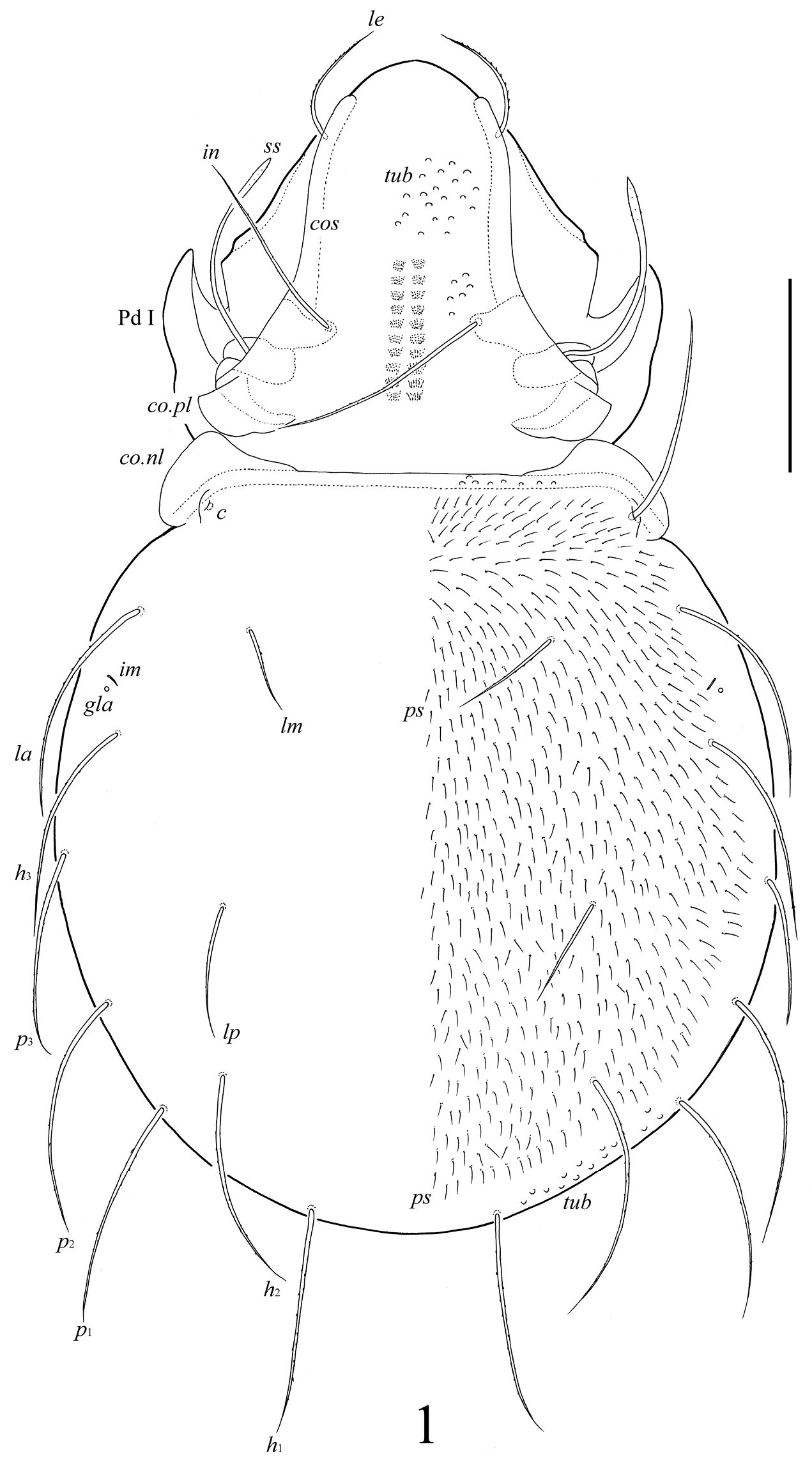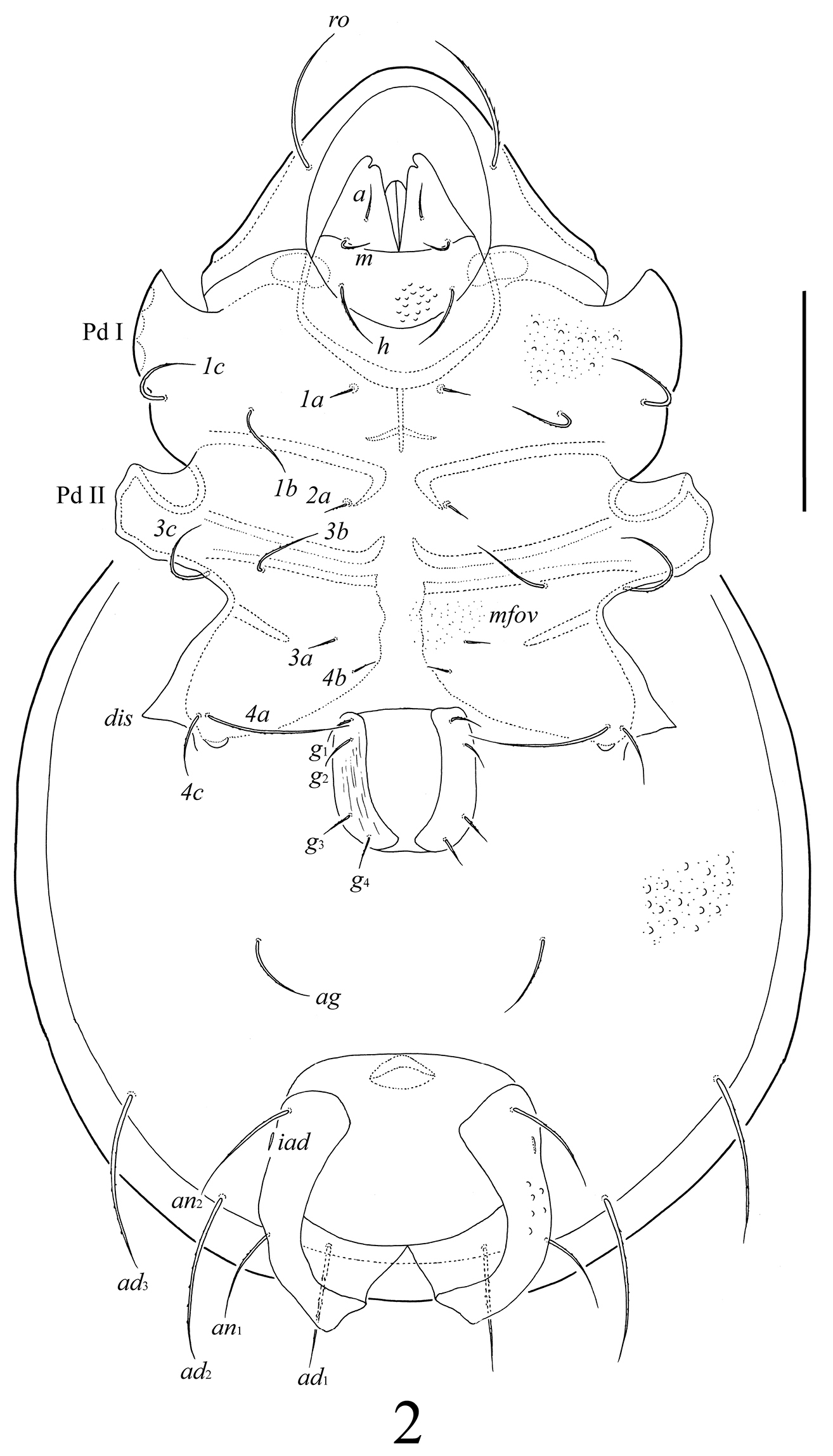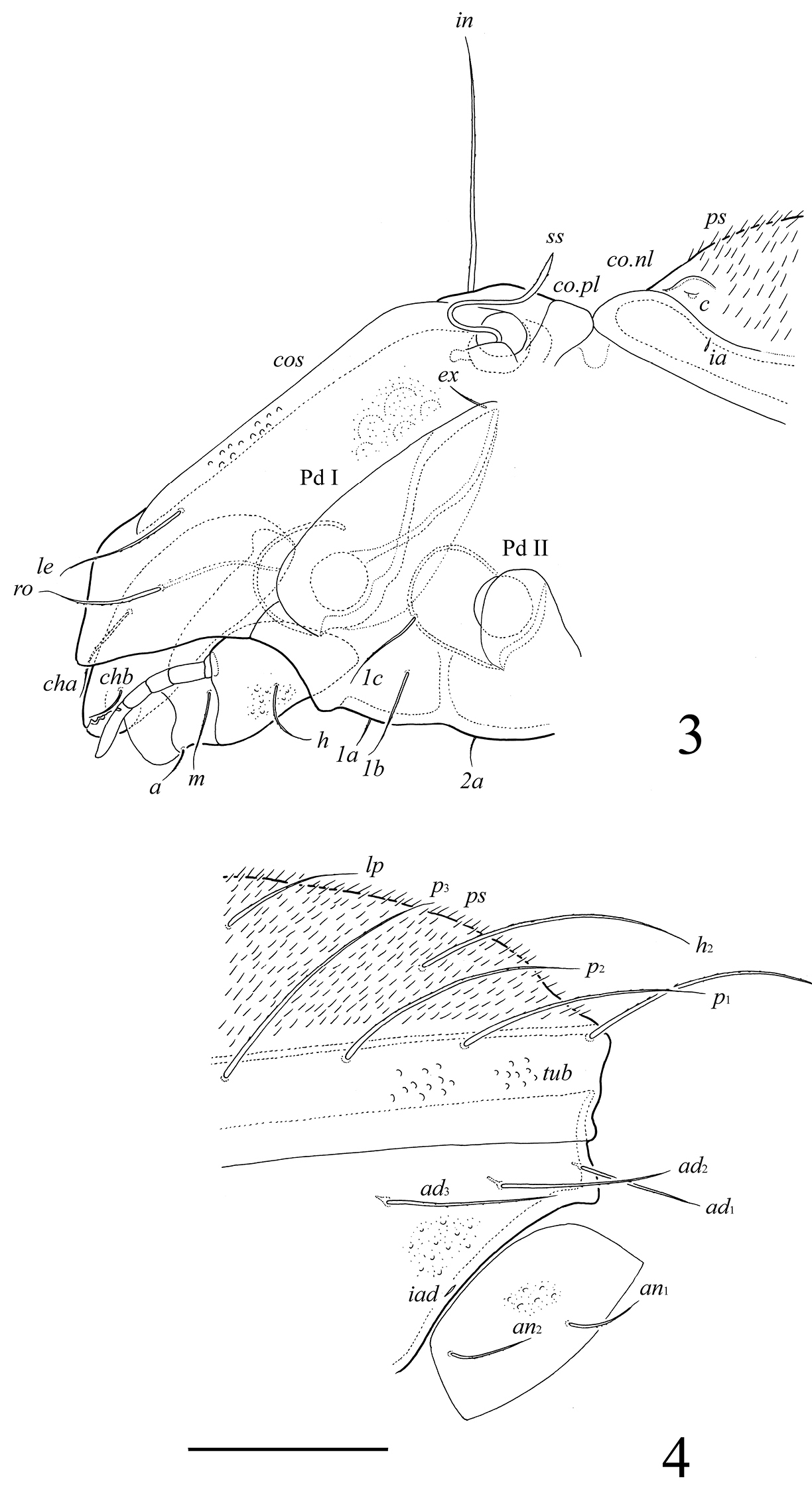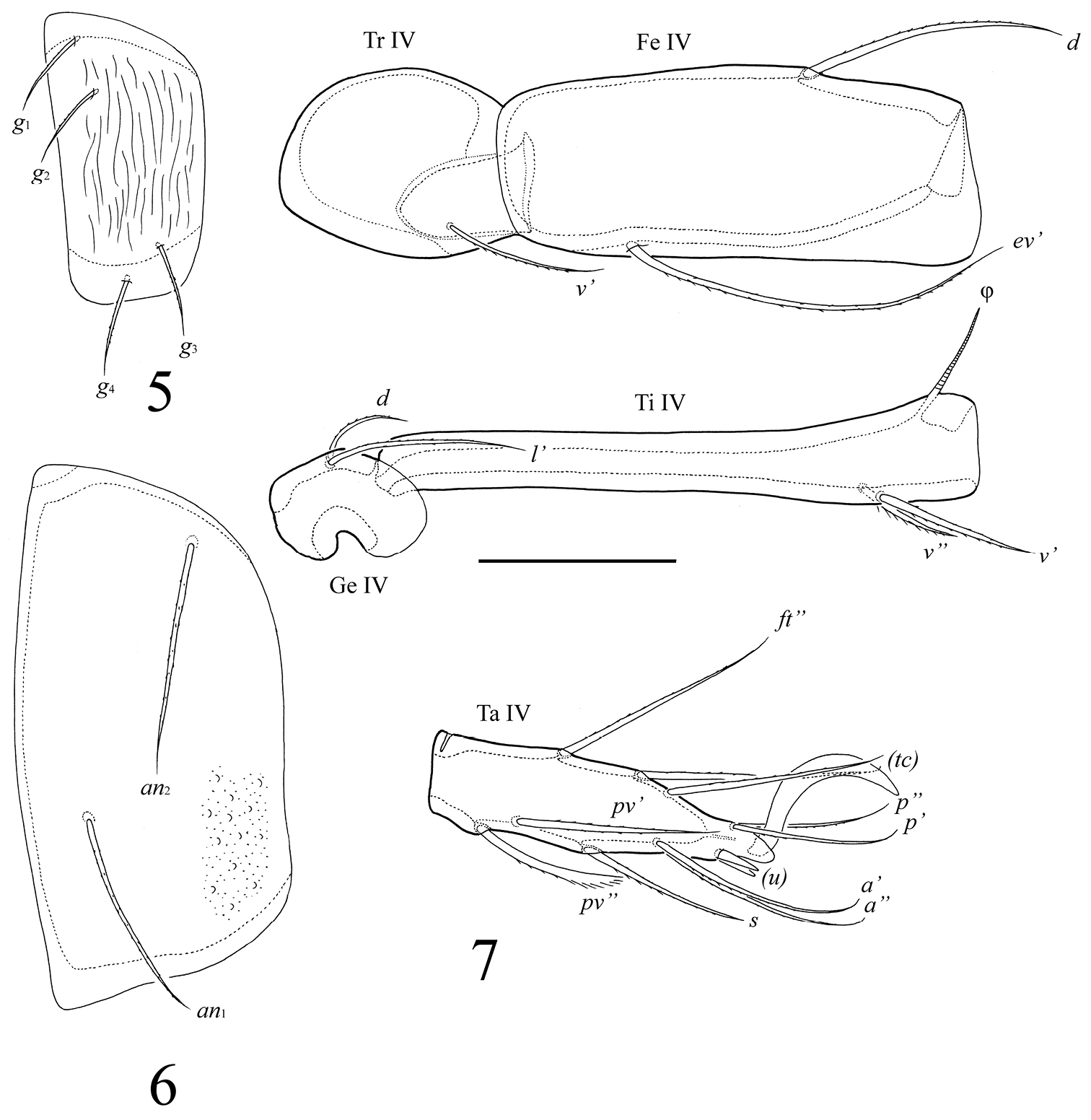






Citation: Ermilov SG, Anichkin AE, Tolstikov AV (2014) Umashtanchaeviella plethotricha, a new genus and species of the family Tetracondylidae (Acari, Oribatida). ZooKeys 408: 51–59. doi: 10.3897/zookeys.408.7605
A new genus of oribatid mites of the family Tetracondylidae, Umashtanchaeviella gen. n., with type species Umashtanchaeviella plethotricha sp. n., is proposed and described from forest litter, the Bu Gia Map National Park, southern Vietnam. The new genus is distinguishable from other otocepheoid genera by the presence of notogastral plethotrichy.
1 See
Oribatida, Tetracondylidae, new genus, new species, Vietnam
Tetracondylidae Aoki, 1961 (Acari, Oribatida, Otocepheoidea) is the large family of oribatid mites, comprising 24 genera, 3 subgenera, 297 species and 11 subspecies, which are distributed in the Pantropical and Subtropical regions (
During our studies of the oribatid mite fauna of Bu Gia Map National Park in southern Vietnam, we discovered a species of Tetracondylidae, representing as new genus, Umashtanchaeviella gen. n. and Umashtanchaeviella plethotricha sp. n.
Holotype (male) and paratype (male) of Umashtanchaeviella plethotricha sp. n. were obtained from southern Vietnam, Binh Phuoc Province, Bu Gia Map National Park, 12°11'N, 107°12'E, 601 m a.s.l., Dipterocarp forest (Dipterocarpus costatus), litter (sifting), 13.XI.2013 (collected by A.E. Anichkin and S.G. Ermilov). Specimens are stored in 70% ethanol (omit in tubes).
The soil litter was collected by taking 16 samples using a stainless frame (50 × 50 cm) and passed through a sifter with the mesh size 2 × 2 cm. The fine fraction was placed in a Winkler extractor with a collection bottle containing 100 ml with 75% ethanol. The extractions were conducted at room temperature for more than 20 days.
Holotype and paratype were mounted in lactic acid on temporary cavity slides for measurement and illustration. The body length was measured in lateral view, from the tip of the rostrum to the posterior edge of the ventral plate. The notogastral width refers to the maximum width in dorsal aspect. Lengths of body setae were measured in lateral aspect. All body measurements are presented in micrometers. Formula for leg setation is given in parentheses according to the sequence trochanter–femur–genu–tibia–tarsus (famulus included). Formula for leg solenidia is given in square brackets according to the sequence genu–tibia–tarsus. General terminology used in this paper follows that of
Rostral, lamellar, interlamellar, notogastral and ventral setae setiform. Lateral prodorsal and lateral notogastral condyles of medium size, normally developed. Notogaster with 10 pairs of well developed setae and numerous plethotrichial setae. Ventral neotrichy absent (epimeral formula: 3–1–3–3; anogenital formula: 4–1–2–3). Pedotecta II rectangular. Adanal lyrifissures iad located nearly to the anal plates.
Umashtanchaeviella plethotricha sp. n.
The specific name is dedicated to our colleague, the acarologist Dr. Umukusum Ya. Shtanchaeva (Universidad Complutense de Madrid, Madrid, Spain), for her extensive contributions to our knowledge of oribatid mites.
Umashtanchaeviella gen. n. can clearly be distinguished from all the other genera of Otocepheoidea by the following apomorphic character: presence of strong (more 250 pairs) notogastral plethotrichy (versus notogastral plethotrichy absent).
The new genus is most similar to representatives of the genera Hydroecocepheus Corpuz-Raros, 1979 (see
http://zoobank.org/7EF674D2-0EAC-4E9F-9AFA-82ACC1782CD8
http://species-id.net/wiki/Umashtanchaeviella_plethotricha
Figures 1–7With character states of Umashtanchaeviella gen. n. as listed above. Body surface microfoveolate and microgranulate; surface of dorsal part of prodorsum, lateral sides of notogaster, anterior part of epimere I, anogenital region and anal plates tuberculate. Genital plates striate. Rostral, lamellar and interlamellar setae long, barbed. Bothridial setae with long stalk and short, weakly developed, lanceolate, head. Exobothridial setae short. Medial prodorsal and notogastral condyles absent; lateral prodorsal and notogastral condyles triangular. Ten pairs of notogastral setae setiform, barbed. More than 250 pairs of short, thin plethotrichial setae on notogaster. Epimeral and anogenital setae setiform, barbed. Adanal setae ad1 shorter than ad2, ad3. Lyrifissures iad located in paraanal position. Formula for leg setae u: L–S–S–S.
Measurements. Body length 614 (holotype), 630 (paratype); body width 348 (holotype), 365 (paratype).
Integument. Body color light brown. Body surface densely microfoveolate (diameter of foveolae less than 1) and microgranulate (granules elongate, length less than 1). Surface of dorsal part of prodorsum, lateral sides of notogaster, anterior part of epimere I, anogenital region and anal plates tuberculate (tub, diameter of tubercles up to 6). Genital plates with thin and numerous stria.
Prodorsum. Rostrum widely rounded. Costulae (cos) well developed, reaching the insertions of lamellar setae and protruding anteriad. Rostral (ro, 77–82), lamellar (le, 77–82) and interlamellar (in, 155–164) setae setiform, barbed. Bothridial setae (ss, 155–164) with long stalk and short, weakly developed, lanceolate, indistinctly barbed head. Exobothridial setae (ex) shortest (20), thin, slightly barbed. Medial prodorsal condyles absent. Lateral prodorsal condyles (co.pl) triangular, rounded distally.
Notogaster. Medial notogastral condyles absent. Lateral notogastral condyles (co.nl) large, triangular, rounded distally, connected to lateral prodorsal condyles. Notogaster has a normal complement of typical, identifiable setae, but with an underlying plethotrichy of minute setae. Ten pairs of notogastral setae well developed, setiform, barbed; medial setae la, lm shorter (73–86) and thinner than other setae (164–176). Distance between setae h1–p1 longer than p1–p2. Plethotrichial setae (ps, more 250 pairs) short (12), thin, straight, smooth, set on small tubercles (insertions of setae visible in high magnification). Lyrifissures ia, im and opisthonotal gland openings (gla) distinct; ip, ih, ips indistinctly developed.
Gnathosoma. Morphology of subcapitulum, palps and chelicerae typical for most Tetracondylidae (for example, see
Epimeral and lateral podosomal regions. All apodemes (1, 2, sejugal, 3) well visible, Apodemes 4 absent. Epimeral setae setiform, slightly barbed. Setae 1a, 2a, 3a, 4b shortest (16–20); 4c (36–41) and 1b, 1c, 3b, 3c (49) longer; 4a longest (65–69). Pedotecta I (Pd I) and II (Pd II) well developed. Discidia (dis) triangular, pointed anteriorly.
Anogenital region. Four pairs of genital (g1–g4, 20–24), one pair of aggenital (ag, 41–45), three pairs of adanal (ad1, 65; ad2, ad3, 90–94) and two pairs of anal (an1, an2, 49–57) setae setiform, barbed. Adanal setae ad1 located in postanal position, ad2, ad3 in adanal position. Distance between setae ad3–ad3 longer than ad2–ad2 and ad1–ad1. Lyrifissures iad short, located in paraanal position.
Legs. Claw of each tarsus smooth. Tarsi without teeth. Formulae of leg setation and solenidia: I (1–4–3–4–16) [1–2–2], II (1–4–3–3–15) [1–1–2], III (2–3–1–2–15) [1–1–0], IV (1–2–2–2–12) [0–1–0]; homology of setae and solenidia as indicated in Table 1. Morphology of leg segments, setae and solenidia typical for Tetracondylidae (for example see
Umashtanchaeviella plethotricha sp. n., adult: dorsal view. Scale bar 100 μm.
Umashtanchaeviella plethotricha sp. n., adult: ventral view (legs not shown). Scale bar 100 μm.
Umashtanchaeviella plethotricha sp. n., adult: 3 prodorsum and anterior part of notogaster, lateral view (palp setae not shown) 4 posterior view of notogaster, lateral view. Scale bar 100 μm.
Umashtanchaeviella plethotricha sp. n., adult: 5 genital plate, left 6 anal plate, left 7 leg IV, left, antiaxial view. Scale bar 50 μm.
Leg setation and solenidia of adult Umashtanchaeviella plethotricha sp. n.
| Leg | Trochanter | Femur | Genu | Tibia | Tarsus |
|---|---|---|---|---|---|
| I | v’ | d, (l), bv’’ | (l), v’, σ | (l), (v), φ1, φ2 | (ft), (tc), (it), (p), (u), (a), s, (pv), e, ω1, ω2 |
| II | v’ | d, (l), bv’’ | (l), v’, σ | l’, (v), φ | (ft), (tc), (it), (p), (u), (a), s, (pv), ω1, ω2 |
| III | l’, v’ | d, l’, ev’ | l’, σ | (v), φ | (ft), (tc), (it), (p), (u), (a), s, (pv) |
| IV | v’ | d, ev’ | d, l’ | (v), φ | ft’’, (tc), (p), (u), (a), s, (pv) |
Roman letters refer to normal setae (e to famulus), Greek letters to solenidia. Single prime (’) marks setae on anterior and double prime (’’) setae on posterior side of the given leg segment. Parentheses refer to a pseudosymmetrical pair of setae.
The holotype is deposited in the collection of the Zoological Institute of the Russian Academy of Sciences, St. Petersburg, Russia; one paratype is in the collection of the Tyumen State University Museum of Zoology, Tyumen, Russia.
The specific name plethotricha refers to the presence of plethotrichial setae on notogaster.
We cordially thank Prof. Dr. Badamdorj Bayartogtokh (National University of Mongolia, Ulaanbaatar, Mongolia) and an anonymous reviewer for the valuable comments, Dr. Umukusum Shtanchaeva, Prof. Dr. Luis Subías (Universidad Complutense de Madrid, Madrid, Spain) and Prof. Dr. Roy A. Norton (State University of New York, College of Environmental Science and Forestry, Syracuse, USA) for consultations. We also thank the staff of the Bu Gia Map National Park for support during the field work. The reported study was supported by RFBR, research project No. 14-04-31183 mol_a.



